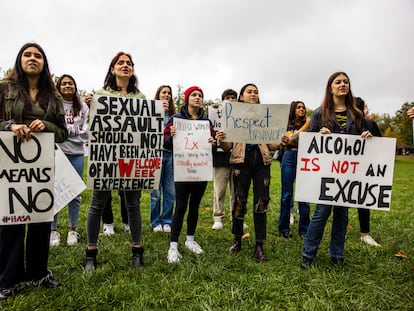Chemical submission: What happens when rape victims don’t remember what happened?
Psychologists, lawyers and experts speak out on the differences and complications — including psychological, emotional and legal — that result from aggressions whose survivors have no conscious memory of the act

You wake up in a bed that is not your own. You wake up in your bed with someone you don’t know. You wake up in a subway car with dozens of people getting on and getting off all around you. You wake up at home alone, with your vagina stinging, or aching, or with a bite mark, or with a bruise that you don’t recall receiving. Once, or more than once. The anguish of having no recollection of the previous hours and the desperation of not knowing what happened. Or at least, not with any clarity. You think: “What did I do?”, “What did I say?”, “Why did I go there?” or “Why did I go with that person?” Suddenly, a certain song makes you uneasy, or you become nauseous from new car smell, or when a person grabs your hand, the act is disconcerting.
This is how, as if they were in a dark spiral, women who have been the victim of a sexual aggression that they can’t remember wake up and continue living. Some of them consumed drugs, or alcohol or both. The so-called chemical submission can be opportunistic — the aggressor takes advantage of the victim having drank or used drugs. More commonly, it is planned — the aggressor purposefully drugs the victim with the objective of assaulting them. It can happen in clubs or bars or parties or festivals, but also in the place we call home, between partners or family members. The lack of recall makes it difficult to process what happened, to integrate it into one’s life, to carry on.
How many times has this happened? It’s hard to say with certainty. It is estimated that 90% of sexual violence is never reported. In general, in Spain it’s calculated that we only find out about one of every 10 aggressions. The latest numbers provided by the Interior Ministry to this newspaper regarding sexual aggressions with and without penetration that took place with the help of drugs or pharmaceuticals reflect a rise in cases: 28 in 2015, 33 in 2016, 43 in 2017, 50 in 2018 and 59 in 2019. In 2020, despite the confinement and restrictions of the pandemic, there were 39. In 2021 there were 64, in 2022 160 were registered; this year, counting only up to June, 136.
The other statistic we know is that of the National Institute of Toxicology and Forensic Sciences, which states that in 2021, of the 3,001 sexual aggressions that were verified, in 994 cases drug testing was administered due to the suspicion that the act could have been committed when the victim was under chemical submission. There were positive results in 72% of these cases. The institute estimates that, given numbers from over the past five years, “approximately 33% of sexual aggressions can be of this type, that is, one in three,” said the then-Minister of Justice, Pilar Llop, when she presented the report.
What do exist are stories and theories — based on the experiences of those who have suffered, who can and want to talk, and those of professionals from diverse fields who accompany them after the fact — of what the consequences are for individuals when their memory has faded to black. “Imagine mothers and fathers whose children have been disappeared, the desperation that they have to know, and how it’s so much when they don’t know, because they wind up imagining things that are so much more terrible than what actually happened,” explains Victoria Carbajal, the director of Asturias’s 24-hour sexual violence crisis center, one of two that are currently operating in Spain, alongside a facility in Madrid. In her center, 476 women have been provided services since November 25, 2020, when it opened. 48 had suffered an aggression via chemical submission. “And those are only the cases we found that were crystal clear,” she says.
For these women, just like for any other, “the intervention they need is the same,” says Yolanda Trigueros, the coordinator for CIMASCAM (the Center for Integral Attention to Women Victims of Sexual Violence — Madrid regional government), open since 2009. That is to say, “an integral intervention that guarantees the recovery to which they have a right.”
Not remembering and guilt
Nonetheless, there are two fundamental differences that set apart sexual aggression via chemical submission. One, from a psychological point of view, is related to not remembering. “The woman knows what has happened, but it is a knowledge without a name and without certainty. We work with what is imagined and what is feared,” says Triguerous. The other is “a guilt that is somehow different from normal guilt, that which is assigned to women by rape culture for not having done everything they could have to protect themselves.”
Last Monday, Trigueros attended a woman who had come to the clinic. “She told me, ‘I knew something had happened to me as soon as I woke up, but I didn’t understand until days later.’ That’s because you have to put the story back together. There are times in which flashbacks happen hours later, days later or months later. That’s when they come at all, because they don’t always.”
According to the most extensive report on sexual violence to date, Integrated empirical analysis and quantitative estimation of (nonconsensual) violent sexual behaviors in Spain, “the information that is available on the impact of sexual violence on victims, which is generally self-reported, corresponds to an underestimation of the reality of sexual violence,” and “there are numerous barriers, above all psychological, which cause victims to fail to report what has happened to them, as if they were simply ‘recorders’ of their lived experiences.” Among them, not identifying what has happened to them as an aggression, confusion, stress, self-incrimination and “genuine problems of amnesia and difficulties in recall.”
And perhaps the memory isn’t visual or auditory, but it is there. “The body has its own memory. The fact that I don’t remember does not mean that my body has forgotten,” points out Violeta García, a psychologist who is an expert in sexual violence. Reactions of rejection or fear or anguish that are difficult to understand may begin to occur: when someone pushes your hair back, grazes your arm, approaches you from behind, an odor, a sound, a voice, a song, a word. “Things that happen to that you can’t place or that you can’t make sense of, but your body serves as the videotape on which it was recorded. It’s not just my declarative memory that takes charge of narrating what has happened to me: nightmares, intense emotions or flashbacks can appear, even if they only contain sensory, and not visual, content.”
In the case of a sexual aggression for which one is conscious, says García, an expert from the Association for the Assistance to Sexually Assaulted Women — Catalonia, it can be narrated in some way. “We somehow position ourselves to integrate the experience and carry on; when we can’t, even if we integrate it and carry on, there is a strong feeling of helplessness, of lack of control, of defenselessness.” And in this nondefense, there is a factor that in recent years has been described as a “point of vulnerability”: knowing or fearing that we have been recorded, and “a lot of fear that it will be distributed, that our family or our friends will see it, or that we will see it.”
Complaints and lawsuits
All this darkness and fear do not only have physical, psychological and emotional repercussions for victims. There are also legal impacts. Carbajal, the director of the Asturias center, is also a lawyer. She says that during a sexual aggression investigation in which the woman does not remember the act and no substances appear on the forensic analysis, “the tendency in many cases is not to believe them.” Marta Calderón, Carbajal’s counterpart at the Madrid crisis center, which has been open since last February, stresses how “the whole complaint and legal process becomes very difficult.”
The problem, says Calderón, is that many times the complaint itself is filed after days or weeks or months, if it is filed at all. “By the time that the woman has been able to shed some light on the darkness. While they have conducted an investigation asking their friends, family, their partner, checking their mobile phone, there’s no longer any way to obtain evidence.” Over the past 10 months, the Madrid center has provided services to 500 women. Of these, 165 have started a legal process; of them, 15% speak of, or have suspicions that they have been victims of chemical submission (25). Only one woman “has been able to prove it with a forensic report,” explains Marta Calderón, the coordinator.
After the complaint is filed and the judicial process begins, Calderón explains that chemical submission “generates little credibility” because “there is an additional difficulty to the account, due to the fact that there is usually no immediate verification of what has happened. Flashes of memory can come days or months later. If a complaint has been filed, it’s possible that later, the victim will want to add to or modify it, and instead of increasing the credibility of the account, it subtracts.”
A testimony “can be strong if there is good training” among prosecutors, judges, advocates and law enforcement, says García, the psychologist. These professionals can interview and gather information “in an exhaustive manner, without victimization, that corroborates the victim’s account, and that comes from both peripheral information [everything surrounding the alleged criminal acts, the context and circumstances that can give clues], and from the body [visible or invisible marks, such as bruises or the feeling of suddenly not being able to bear being touched].” These are indications, she says, “and none of them, on their own, are certainties or proof, but knowing how sexual violence operates, [these professionals] can make connections between them in an informed manner.”
This can “help” to understand a kind of violence that until now has been very little explored, and the women that suffer from it. Yolanda Trigueros, of the Madrid center, spells out this horror: “Sexual violence is a form of terrorism, and of taking away women’s power. But if, on top of everything else, you can’t remember it, it’s like entering into a void, into uncertainty. Imagine it for a moment. That is the horror.”
Sign up for our weekly newsletter to get more English-language news coverage from EL PAÍS USA Edition
Tu suscripción se está usando en otro dispositivo
¿Quieres añadir otro usuario a tu suscripción?
Si continúas leyendo en este dispositivo, no se podrá leer en el otro.
FlechaTu suscripción se está usando en otro dispositivo y solo puedes acceder a EL PAÍS desde un dispositivo a la vez.
Si quieres compartir tu cuenta, cambia tu suscripción a la modalidad Premium, así podrás añadir otro usuario. Cada uno accederá con su propia cuenta de email, lo que os permitirá personalizar vuestra experiencia en EL PAÍS.
¿Tienes una suscripción de empresa? Accede aquí para contratar más cuentas.
En el caso de no saber quién está usando tu cuenta, te recomendamos cambiar tu contraseña aquí.
Si decides continuar compartiendo tu cuenta, este mensaje se mostrará en tu dispositivo y en el de la otra persona que está usando tu cuenta de forma indefinida, afectando a tu experiencia de lectura. Puedes consultar aquí los términos y condiciones de la suscripción digital.











































